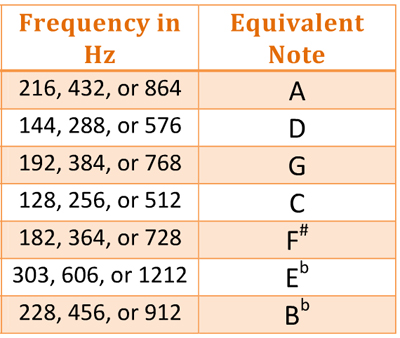

If you google the topic, you will discover that the debate over which tuning system is optimal is a very controversial and heated one. In preparation for this article I have spent days reading blogs and watching YouTube videos on the subject. The arguments can get pretty technical with proponents of 432 claiming that it resonates with the Heart Chakra, repairs DNA and restores both spiritual and mental health. There is even the suggestion that 432 tuned music stimulates the right brain, responsible for our most desirable human traits.
Since I've already written about the research pertaining to the left and right hemispheres of the human brain, I will defer to Dan Eden's article here on viewzone for a detailed understanding of this phenomenon. I'll summarize the duties of each hemisphere below:
|
LEFT BRAIN FUNCTIONS |
RIGHT BRAIN FUNCTIONS |
It seems obvious that our current civilization is geared towards left brain traits and many can pose the argument that this has resulted in a plethora of today's social problems. I spent a considerable amount of time searching scientific journals to see if any studies had been done which demonstrated the neurological effects of 432 vs 440 Hz but, surprisingly, there were none.
Some scientists have noticed that the frequencies of the various notes can be expressed in whole numbers in the 432 Hz tuning system. The 440 Hz system results in more complex fractions. Often the simplest solution is most likely the correct one.
|
Modern Standard Tuning (A = 440 hz, C = 261.63 hz)(Sources)
Note Frequency (hz) -- Mid Low (1 octave below middle C)
C 130.81 -- Mid (middle C)
C 261.63 -- Mid High (1 octave above middle C)
C 523.25 |
Stradivari/Verdi Tuning (A = 432 hz, C = 256 hz),
calculated using the Pythagorean method of 3:2 ratio for dominants, 11:8 for sub-dominants, 2:1 for octaves.
Note Frequency (hz) - Mid Low (1 octave below middle C)
C 128 -- Mid (middle C)
C 256 -- Mid High (1 octave above middle C)
C 512 |
Remember that the frequency is measured in cycles per second, which means it used the standard unit of time to determine the frequency number. Since the unit of time -- the second -- is based on the rotation of the earth = 1/86,400 th of a day, this could emphasize some natural connection and perhaps there is some kind of mathematical resonance going on here.
I did locate an experiment published in the Journal of the Acoustic Society of America (114, 2409 2003) which had music students listen to classical compositions written by some world famous composers in 432 Hz tuning (Chopin, d'Albert, Bach, Debussy, Mozart and Reger) which were played in their original pitch and then played in 440 Hz.
While the students showed no significant preference the experiment did confirm that these early composers were, in fact, using the 432 Hz tuning to create their masterpieces. This might support the idea that they were more creative because the music stimulated their right brains. The critique of the experiment was that these were music students who were accustomed to the 440 Hz pitch and perhaps were influenced by their familiarity with the 440 Hz tones. We'll talk more about this study later in Part 3.
Most studies reveal that the amygdala, an area of the brain about the size of a walnut that exists in the left and right hemispheres, is active in either hemisphere when subjects either like or dislike music. Unfortunately, all of the experiments use the 440 Hz tuning. What is badly needed is an fMRI study where non-musicians are exposed to unfamiliar musical pieces played in 440/432/and a control. This way the neurological effects could be evaluated and the debate would perhaps be ended.
 The research conducted with grants from the Rockefeller Foundation (referenced earlier) determined that 440 Hz music was good at making people work harder and fostered personality traits more in tune with Startrek's Vulcan character, Spock. These are pure left brain traits which stifle creative thought and null the emotions. It is clear why these traits were desirable in the Third Reich. It also might explain why modern music, which changed to the 440 Hz standard in 1939, has had such a negative effect on today's culture.
The research conducted with grants from the Rockefeller Foundation (referenced earlier) determined that 440 Hz music was good at making people work harder and fostered personality traits more in tune with Startrek's Vulcan character, Spock. These are pure left brain traits which stifle creative thought and null the emotions. It is clear why these traits were desirable in the Third Reich. It also might explain why modern music, which changed to the 440 Hz standard in 1939, has had such a negative effect on today's culture.
Other interesting differences
Much is made of the fact that 440 Hz is "unnatural" and creates subtle disharmony to the listeners. The argument posed is that when the two frequencies are examined in Cymatics experiments, the patterns show that 432 Hz creates distinct shapes which indicate that they resonate with nature. The 440 Hz tuning creates indistinct patterns revealing a lack of coherence.
I have included a short video which will demonstrate this effect better than I can describe it. Have a look:
Here is a short video that demonstrates the difference that a song will sound when the guitar is tuned such that the "A" string is 440 vs 432 Hz:
We'll talk more about the inherent problems of re-tuning an instrument with frets later. But first, I'd like to turn you on to a composition made by a plant! That's right, the artist is Anthurium (anthurium andreanum) and it was connected to a MIDI computer interface and allowed to experience (hear) its own electrically generated tones.
According to the posted description:
The music in this recording has actually been performed by a plant, Anthurium (anthurium andreanum), thanks to a specific electronic device. Plants emit signals in reaction to external stimuli and to communicate with everything. These signals are detectable as variations in the bio-electrical field of the plant and can be converted into a MIDI signal (Musical Instruments Digital Interface). I sent this MIDI signal into a synthesizer and programmed a soft, soothing sound tuned at 432 Hz. After some time being connected to such device and producing sounds, plants seem to become aware of the process; they seem to understand that those sounds are coming from them... and they start playing with it.
The video is longer than an hour but quite pleasing to the ear. I will only post the link as it would slow down the loading of this page considerable. (just click the image below to go to the YouTube video)

Of course, the benefits of music on plant growth have been known for some time now but these observations have mainly come from marijuana growers who claim that their cannabis plants seem to prefer classical music. To the best of my knowledge the recordings used have all been in 440 Hz, the standard "concert pitch". So perhaps there is another area where 432 Hz tuned music could be investigated.
More details on 432 Hz tuning
Before I go further, many of you are probably wondering how to tune your guitar to the 432 Hz scale. I will post the frequencies here:

If you are not a musician and want to hear some popular tunes in 432 Hz you have two good options. First, it is believed that musicians such as John Lennon (Imagine) and some of the early works of Bob Marley (Three Little Birds) were recorded on instruments tuned to the 432 Hz scale. There are many many more if you search on YouTube. It seems this right-brain tuning has been known for some time and many artists have experimented with it or created their tunes using it.
The problems come when record companies attempt to record the music and require the addition of other musicians who may have instruments that cannot easily re-tune. Wind instruments like the saxophone, clarinet, flute as well as "solid tuned" instruments like marimbas and xylophones cannot adjust from their 440 Hz tone. Even the guitar and other fret instruments will have some dissonance when playing in the higher octaves because of the set distance between the frets.
Another option for listening to 432 Hz is to convert tunes recorded in 440 Hz to 432 Hz with programs like Audacity, which is free to download and world on Mac and PC platforms. These programs do not just "slow down" the music by the 8 Hz difference but somehow preserve the tempo and audio (not 100%) and deliver a pretty awesome result. Many of the so-called "432 Hz" tunes you find on YouTube have been converted by this method.
My all time favorite is No Quarter by Led Zeppelin. I wanted to share this with you (in 432) but youtube took it down... So here is Stairway To Heaven (432). If you liked Zep in the past you will notice the difference. Turn it up and notice that there is no distortion (and your Mom will not yell "Turn that stuff down!"). There are rumors that this was originally recorded in 432 but I could not find any validation to this claim.
ENJOY!
Wow. See what I mean? OK... there's much more so hang in there. Next up is a review of hard scientific evidence of the benefits from listening to 432...


Illustration courtesy of National Geographic. See their article on Neanderthals here.
Flute's Revised Age Pushes Back the Sound of Music
NY Times In hillside caves of southwestern Germany, archaeologists in recent years have uncovered the beginnings of music and art by early modern humans migrating into Europe from Africa. New dating evidence shows that these oldest known musical instruments in the world, flutes made of bird bone and mammoth ivory, are even older than first thought.
Scientists led by Thomas Higham of the University of Oxford in England reported last week that improved radiocarbon tests determined that animal bones found with the flutes were 42,000 to 43,000 years old. This is close to the time when the first anatomically modern humans were spreading into Central Europe, presumably along the Danube River valley.
Earlier tests had yielded dates of 35,000 years ago for artifacts at several caves where flutes and also ivory statuettes of voluptuous women have been found near Ulm, Germany, and the Danube's headwaters. The best preserved bone flute, with five finger holes, was collected at Hohle Fels Cave. The new analysis was based on material from the nearby Geissenklosterle Cave.
Some scholars were slow to accept the first reports of the 35,000-year flute chronology in assessing the timing and setting of cultural changes arising from the arrival of Homo sapiens, who would then replace the native Neanderthals 30,000 years ago. Radiocarbon ages older than 30,000 years can be unreliable.
The new findings, published in The Journal of Human Evolution, "are consistent with a wide range of innovations coming from the Upper Danube," Nicholas J. Conard, an archaeologist at Tubingen University in Germany, said in an e-mail. Dr. Conard, one of the authors of the report, was the excavator of the artifacts at several of the caves.
After several discoveries of pieces of flutes, samples of figurative art and distinctive personal decoration in the caves, Dr. Conard said the new dates supported the hypothesis that the Danube was "a key corridor for the movement of humans and technological innovations into Central Europe between 40,000 and 45,000 years ago."
In Dr. Higham’s research, the animal bones being dated were buried in the same ground layers as the flutes in Geissenklosterle Cave. They were treated against contamination by advanced "ultrafiltration." The bone results, the researchers wrote, "strongly imply that the previous dates were affected by insufficient decontamination of the bone collagen prior to dating."
If the new dates are correct, scientists said, modern humans first moved through the Upper Danube region, making music, before an extremely cold phase of the ice age, 39,000 years ago. In a chronology based on younger dates for the flutes, it was supposed that modern humans had waited for better weather before heading through the Danube.
The above story indicates that Neanderthals and modern humans cohabited in the area where the caves are located and allows, at least in theory, the possibility that these flutes were made by our Neanderthal ancestors.
Both modern day humans and Neanderthals fall under the species homo sapiens. It is thought that Neanderthals first evolved about 600,000 years ago with subsequent improvements in their anatomy occuring around 350,000 years ago. They left a rich archaeological record of their existence up until about 30,000 years ago when, for some reason, they went extinct.
Neanderthals had larger brains (and presumably were more intelligent) than modern humans. They had a cranial capacity of 1600 cc as opposed to the 1400 cc of humans today. It is thought that these two sub-species of homo sapiens diverged in the evolutionary tree about 500,000 years ago.
Because their genetic origins and historical dates were only recently known to science, a sort of paradigm developed where they were viewed as dumb, knuckle dragging ape-like beings. Any discovery of art, music or even flint technology was automatically attributed to modern human ancestors. Neanderthals were believed incapable of aesthetics. But this view has been changing with new evidence to the contrary.
Is it possible that Neanderthals had music? Is it possible that they developed the heptatonic (8-note) scale that we still use today? Is it possible that they drew the fantastic cave paintings that were discovered in the Hohle Fels cave? These are some of the questions that need to be reconsidered.
The argument is made that Neanderthals, because of their increased brain size, required more calories in their diet than the lesser brain sized sapiens sapiens, or modern man. The advent of the ice age is thought to have reduced the supply of food and culled the Neanderthals by starvation. But this view might need revising if more arhchaeological sites like the caves in Ulm and elsewhere are examined more closely.
We know, for example, that Neanderthals buried their dead and often included artifacts with the deceased -- a practice that suggests belief in an afterlife and potentially a spiritual or religious aspect of their culture. Since music has been shown to be an integral part of spiritual practices, it is entirely possible that we owe our musical heritage to the Neanderthals.
COMMENTS:
Dear Gary:
I must admit I did not study in detail the entire article you wrote on the 432 vs 440 Hz tuning issue, but it seems to me you are lumping the issue of equally tempered intervals vs pure intervals in with the totally unrelated issue of what the reference for the one note "A" is.
In the equally tempered tuning, the ratio between half steps is the twelth root of 2 (which is around 1.059). In that way, by the time you go thru 12 half steps, and reach the octave, you are back at a ratio of 2. Hence, the 12th roof of two. There is an error, but it is equally distributed throughout all the keys.
In the pure intervals tuning, the ratios between notes are whole numbers. However, this causes certain keys to behave differently, since only one key must be the reference.
It seems like what you are arguing is really
- equally tempered tuning with A = 440 Hz
- Versus
- pure intervals tuning with A = 432 Hz
--joe
